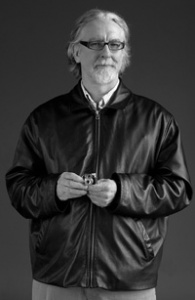
Portrait of Thaddeus Holownia, Strathbutler 2003 (photo – James Wilson)
In 2003, Sackville photographer and educator, Thaddeus Holownia was given the Strathbutler Award in recognition of his impressive career. Jurors Gordon Dunphy, Liz Wylie and Bob Kavanagh selected Holownia for the honor, praising both the breadth and quality of his work as well as his impressive community service.
His photographs have a unique clarity and depth of vision both technically and within the realm of aesthetics. His signature use of the 7”x 17” format produces a rare sense of compositional strength and complexity illuminating his continuing examination of nature and man’s effect on it. His body of work generates charged socioeconomic metaphors that speak of his love of place. He exhibits internationally and his works are to be found in important private and public collections.
- A Gallery of Thaddeus Holownia’s work
- All posts on Thaddeus Holownia
- Website: holownia.com
While continuing his impressive creative output, Holownia has forged an outstanding teaching career at Mount Allison University, Four time recipient of the Paul Paré Award for Excellence in Teaching and Research in conjunction with exemplary service to the University and the greater community. He established the Sackville Film Society and owns and operates Anchorage Press. He was awarded a Fulbright Fellowship.
In the artist’s words
My photographic prints are located within the American Documentary genre. I use view cameras in many formats, primarily 5”x7’ and 7”x17”
I am interested in the physical world and the ability of the photograph to depict it.- the layering of information and the notion of time in an extended period of observation. My work involves the strategy of series. This is manifested in a number of ways. It could be observing changes on the same landscape over a period of time or it could be the catalogue of like objects and places.
The subject that interests me is nature, the altered landscape and architecture. I try to deal with how human intervention changes the landscape, how the forces of nature mould human structures, how the two coexist. The meaning that resides in my bodies of work goes beyond the visual description; they stand as a history of the play between human intervention and the landscape. The result is both an anecdote of an ordinary place and a metaphor for our relationship to place and environment. What emerges is a sense of vulnerability and the inexorable force of time.
